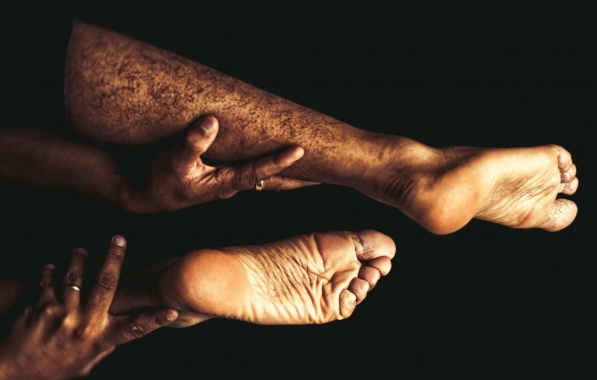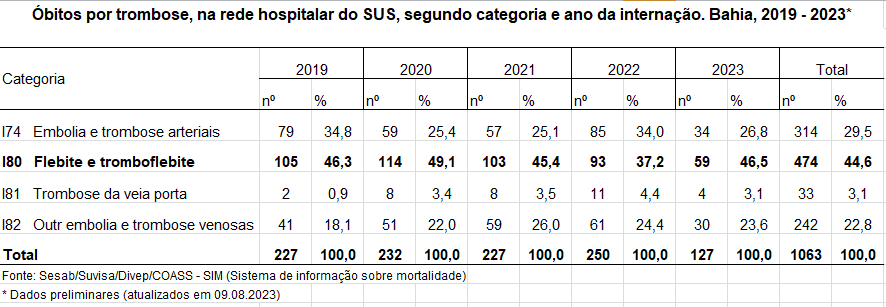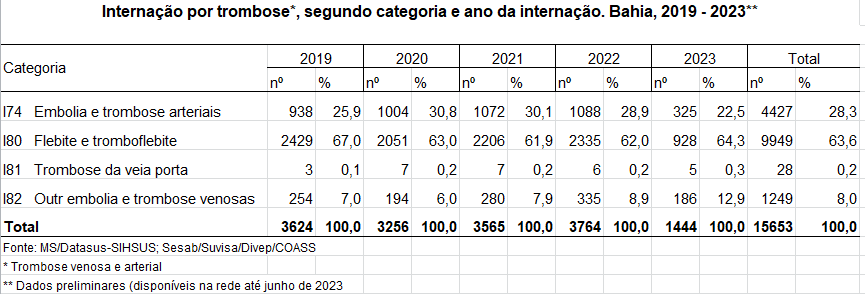More than a thousand people have been hospitalized and 127 have died of blood clots in Bahia this year. According to data from the State Department of Health (Sesab), the numbers indicating hospitalizations due to arterial embolism and thrombosis in hospitals in the state network increased by 28.9% between 2019 and 2022.
In the same period, hospitalizations increased from 938 to 1,088, and deaths due to the disease increased by 34%. There were 79 deaths from the disease in 2019 compared to 85 deaths in 2022. The data refer to hospitalizations in the SUS hospital network and deaths from thrombosis.
Click on the image to enlarge | Image: clone/sysap
Data provided by Sesab also showed that more hospitalization records occurred in females than males. In the past four years, 8,989 women and 6,664 men have been hospitalized.
Click on the image to enlarge | Image: clone/sysap
Another very common type of disease, venous occlusion and thrombosis, recorded an 8.9% increase in hospitalizations. The number of cases of treatment for the disease increased from 254 to 335 between 2019 and 2022.
In 2022, the Brazilian Society of Vascular and Vascular Surgery published a study in which it cited Bahia as the state in the northeast with the highest number of leg or foot amputations. The country performed 21,069 lower limb amputations in the public service between 2012 and 2021.
In an interview with Bahia Notícias, vascular physician and vascular surgeon Cesar Amorim, president of the Associação Bahiana de Medicina (ABM), explains these figures and points out that more than 80,000 residents of the Northeast had lower limb amputations during this period.
Pernambuco is second with 16,324 and Ciara is third with 10,574. If we add the total population in the Northeast between 2012 and 2021, we come to about 80,124 residents of the Northeast who have had lower limb amputations,” says the doctor.
The expert points out that there are two types of thrombosis: arterial thrombosis that occurs in the arterial circulation, and venous thrombosis that occurs in the pathways responsible for returning blood from the tissues to the heart and then to the lungs to obtain oxygen. .
“It is arterial thrombosis that can lead to a loss of circulation to tissues, for example, to the lower extremity and then can lead to amputations. When a venous thrombosis causes a vein to become obstructed, the extremity usually swells and sometimes this clot can travel to the the heart and then into the lungs and cause a pulmonary embolism that can be fatal,” explains the specialist.
According to Amorim, risk factors that can lead to a person developing arterial thrombosis are smoking, diabetes, high cholesterol, alcohol consumption, physical inactivity, obesity, heart disease, and advancing age.
These risk factors lead to the formation of fatty plaques in the blood vessels, and these plaques develop over time and can eventually lead to a blockage of the blood vessel. The vessel unfairly transmits hypoxia to the tissues because the vessel is obstructed and leads to tissue death, which increases amputations.
As for the use of contraceptives, the doctor notes that medications can contribute to the development of venous thrombosis.
“Sometimes venous thrombosis is higher than arterial thrombosis. But these are also causes that lead patients to blockage and poor circulation with a lack of oxygen to this particular tissue.”
The expert says that men are more affected than women by arterial thrombosis. As for hospital admissions, they happen mostly to people with diabetes, and these people are 15 to 30 times more likely to have lower limb amputations, compared to patients without diabetes.
80% of non-traumatic amputations occur in patients with diabetes. The incidence of amputation ranges between 50 and 90 per 10,000 diabetic patients annually.”
The lack of sensitivity of some diabetics in the lower extremities can lead to ulcers developing. According to the expert, 20% of diabetic patients suffer from ulcers, 50% of these ulcers become infected and about 20% develop into limb amputation.
According to the expert, the Covid-19 pandemic was also a factor that caused an increase in amputations. “The number of amputations in the Northeast experienced a steadily increasing exponential increase in 2019 and 2021, and was also maintained in 2022. This leads to a near amputation.”
The vascular specialist also indicates that a physical examination is necessary in diagnosing the disease and says that patients with thrombosis suffer from localized pain, bluish color and numbness in the area in addition to paleness.
According to the doctor, the prevalence of arterial thrombosis is more or less about 4% of the population. This increases proportionately with age and can range from about 0.9% under 50 to about 14% to 15% over 70.
Arterial thrombosis can be treated in urgent patients with anticoagulant drugs, antifibrinolytics, or surgical procedures to clean the vessels. In cases of chronic thrombosis, where the patient has an advanced wound, clinical treatment may be sufficient.
“If at first clinical treatment does not have a beneficial effect, then you have to go for surgical treatment and through occlusion of that vessel or vascular surgery, which is minimally invasive surgery, where we try to block and avoid a major amputation or even save that limb that was at risk of amputation.”

“Wannabe internet buff. Future teen idol. Hardcore zombie guru. Gamer. Avid creator. Entrepreneur. Bacon ninja.”



